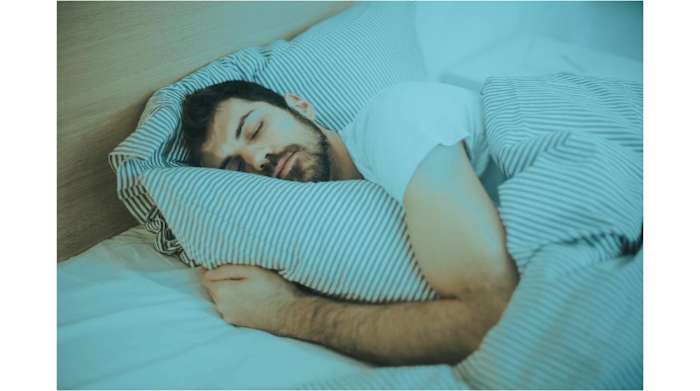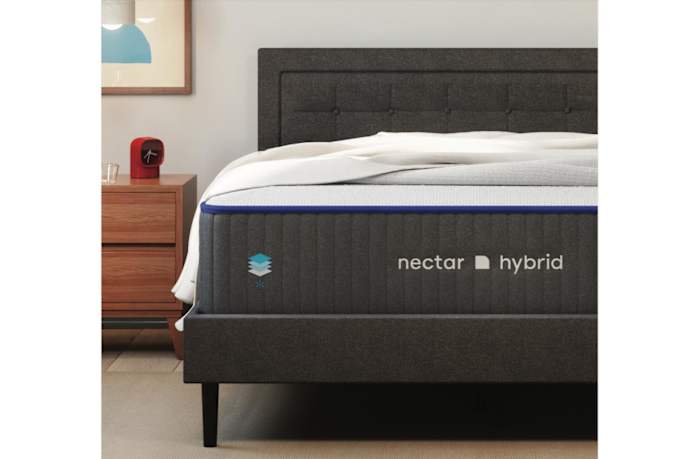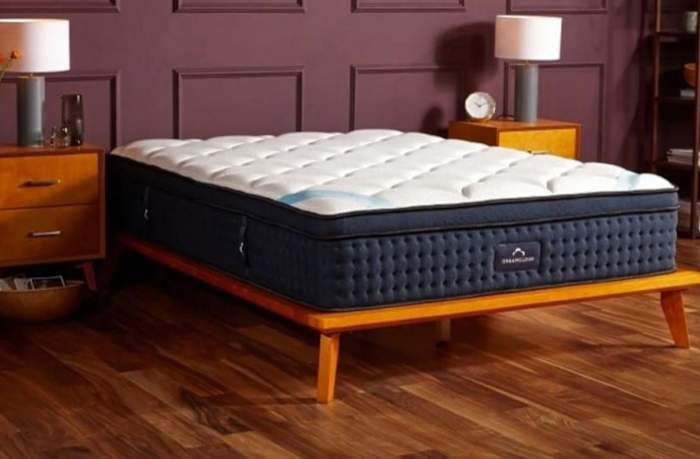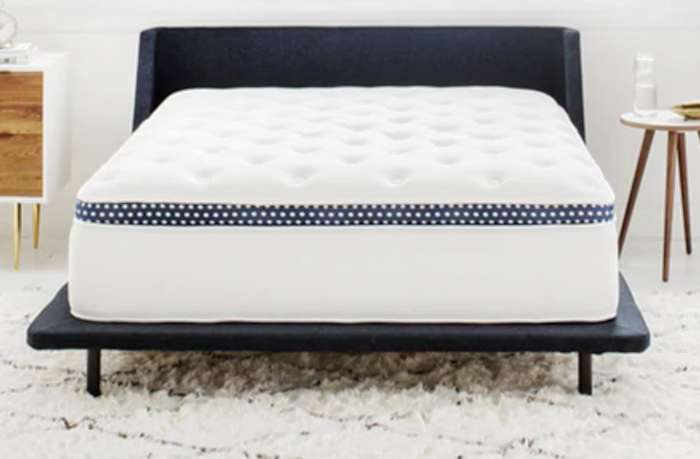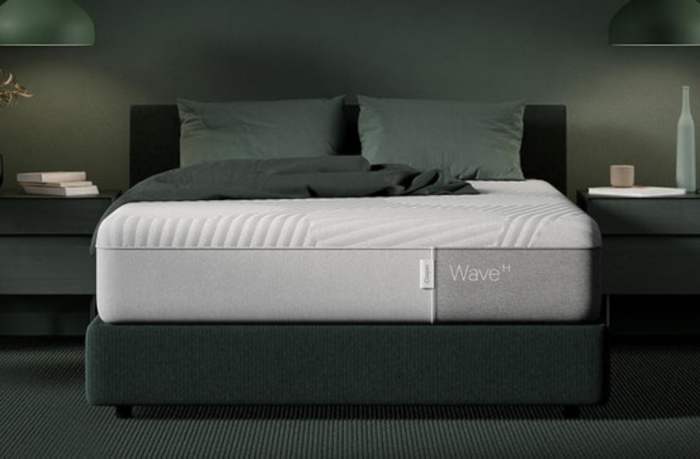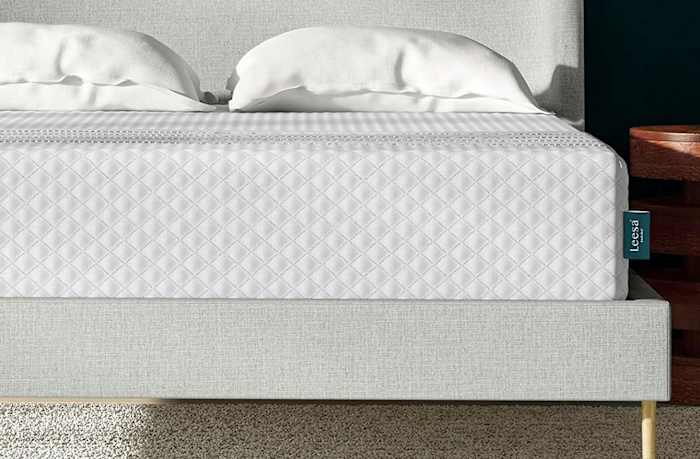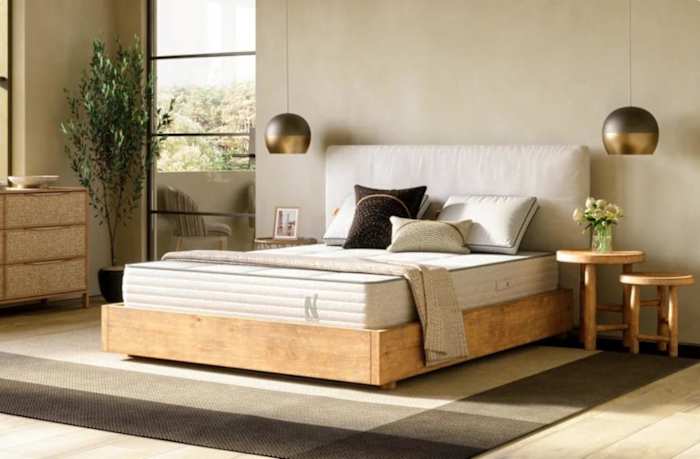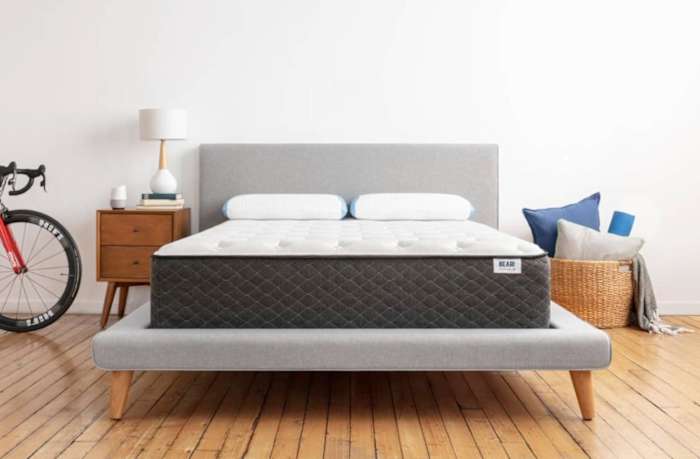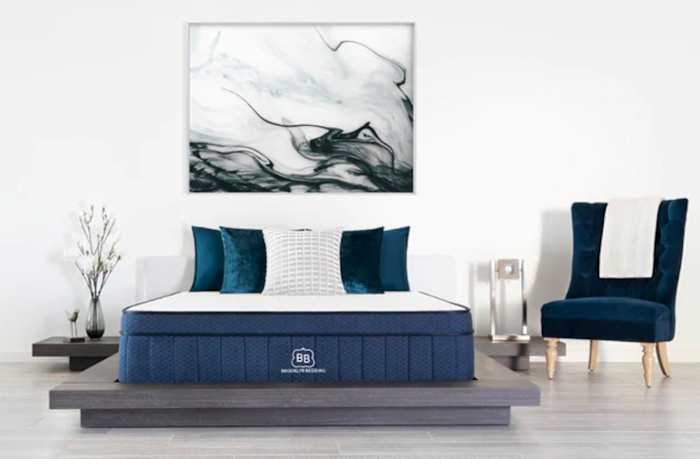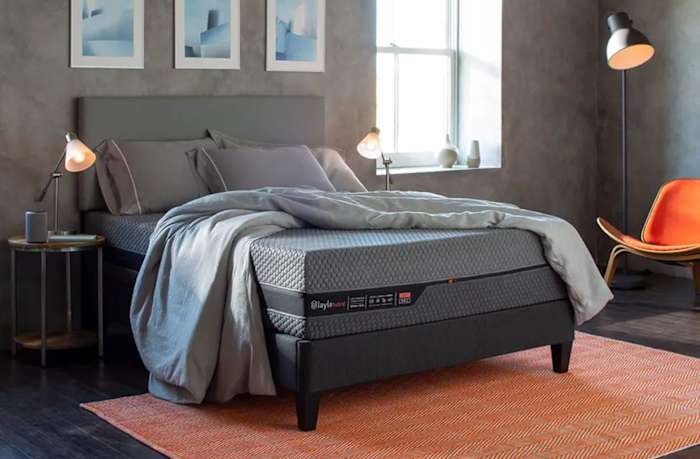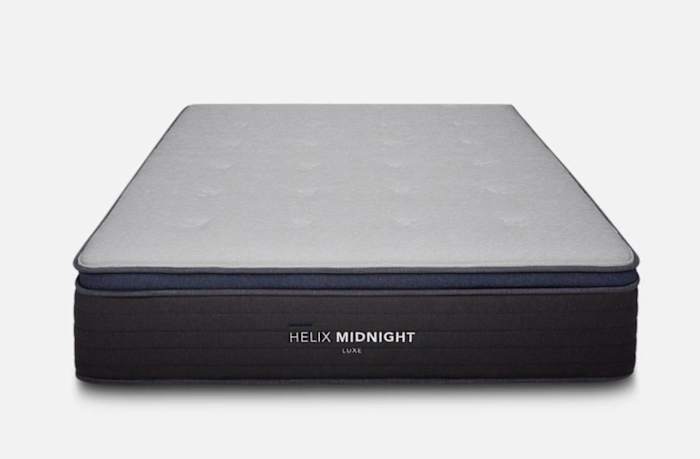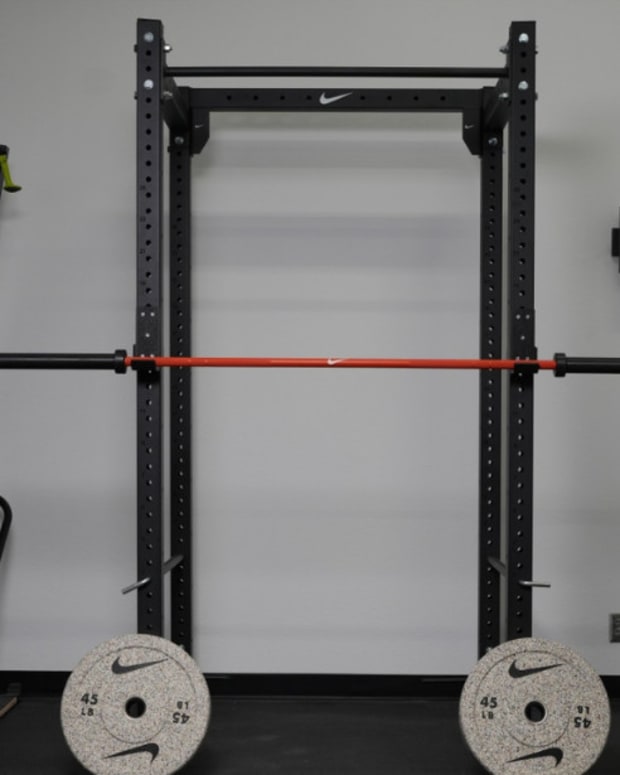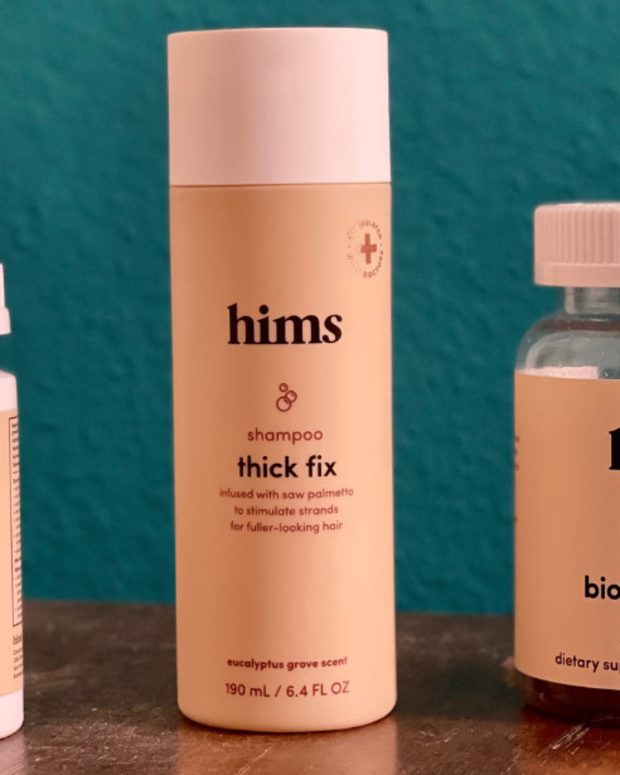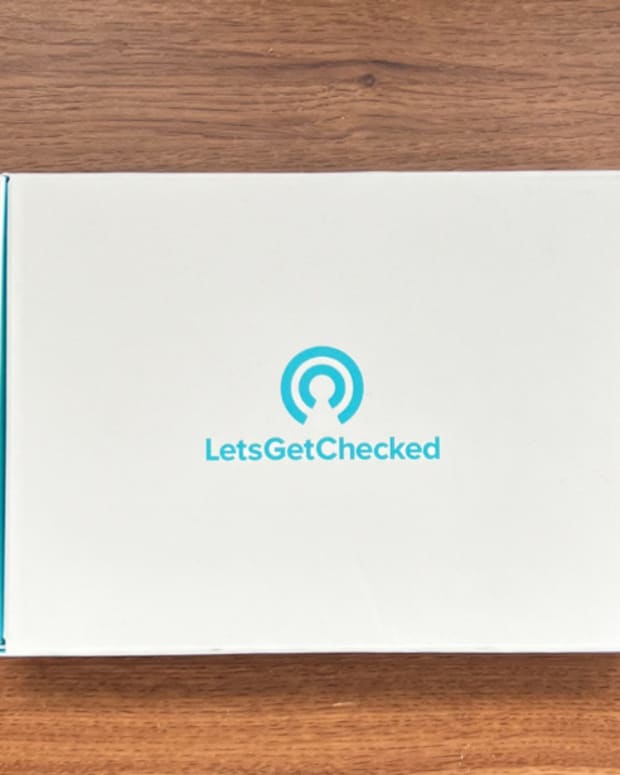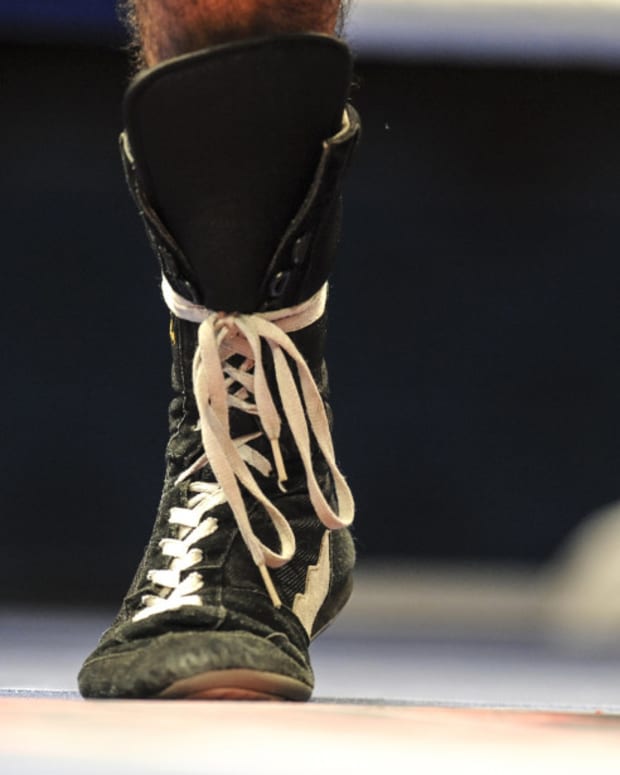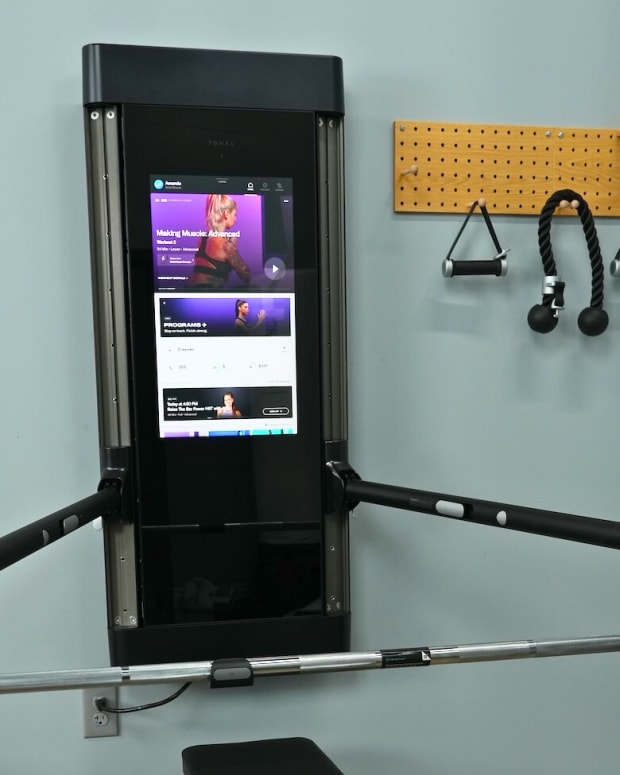The products featured in this article have been independently reviewed. When you buy something through the retail links on this page, we may earn commission at no cost to you, the reader. Sports Illustrated editorial staff are not involved in the creation of this content. Learn more here.
There are few things that ruin a good night of sleep faster than night sweats. If you’re a hot sleeper, you probably know this struggle all too well. There are many reasons you might overheat at night, one of them being the wrong mattress. Older-style memory foam mattresses are notorious for trapping heat, but the best cooling mattresses combine various materials—including redesigned foams—that offer improved air circulation and better temperature regulation to help keep you comfortable.
In this guide, we’re highlighting our favorite cooling mattresses for every type of sleeper. You’ll find innerspring, hybrid and memory foam options that suit different comfort preferences and sleeping styles. We’ll go over the most common types of mattresses, who they’re best for and how to narrow down your choices to find the right one for you. We’ll also dig into various cooling technologies to explain exactly how they work.
Our Picks for the Best Cooling Mattresses of 2024:
- Best Overall: Saatva Classic
- Best Cooling Gel Memory Foam Mattress: Nectar Classic Hybrid
- Best Hybrid Cooling Mattress: DreamCloud
- Best Firm Cooling Mattress: The WinkBed
- Best High-End Cooling Mattress: Casper Wave Hybrid
- Best Cooling Mattress For Side Sleepers: Leesa Sapira Hybrid
- Best Natural Cooling Mattress: Nolah Natural
- Best Mattress for Cooling and Back Pain: Bear Star Hybrid
- Best Cooling Bed-In-A-Box Mattress: Brooklyn Aurora
- Best Flippable Cooling Mattress: Layla Hybrid
- Best Cooling Mattress for Couples: Helix Midnight Luxe
Best Overall: Saatva Classic
Specs
- Price: $1,770 (Queen)
- Type of mattress: Innerspring
- Firmness level: Available in Plush Soft, Luxury Firm and Firm
- Materials: Recycled steel coils, organic cotton, memory foam
- Available sizes: Twin, twin xl, full, queen, king, split king, cal king, split cal king
- Trial period: 1 year
- Who it’s best for: Back and stomach sleepers, those who prefer the feel of a traditional pillow-top mattress and those who want firmness options
The Saatva Classic is an upgraded version of the traditional pillow-top innerspring that you may have slept on in the past. It has two layers of springs—a base unit made of steel coils and a support layer of pocketed coils. This dual coil system maximizes airflow so you feel cooler while you sleep and provides proper support so your spine stays aligned. The pocketed coil layer has ergonomic zones. It’s firmer in the center third of the mattress and softer near the head and shoulders, so it contours to your body in any sleeping position.
A wire frame and high-density memory foam layer in the center third of the mattress help to alleviate back pain related to poor spinal support. On top is a quilted Euro pillow top (Euro pillow tops are sewn into the mattress, which eliminates the "muffin top" look of most pillow-top mattresses). This Saatva pillow top is made with organic cotton, which is one of the most breathable fabrics, so it won’t trap heat even on hotter nights.
The testing team loves the Saatva Classic because it’s somewhat customizable too. You can select from three firmness levels—Plush Soft, Luxury Firm and Firm—and two heights, 11.5 or 14.5 inches. The bed comes handmade to order and arrives fully expanded with free white glove delivery.
Best Cooling Gel Memory Foam Mattress: Nectar Classic Hybrid
Specs
- Price: $1,199 (Queen)
- Type of mattress: Hybrid
- Firmness level: Medium-firm
- Materials: Antimicrobial cover, CertiPUR-US memory foam, coils
- Available sizes: Twin, twin xl, full, queen, king, split king, cal king
- Trial period: One year
- Who it’s best for: Back sleepers, couples and memory foam lovers
The Nectar Classic Hybrid is part of the brand’s new hybrid mattress collection—it’s first foray into the hybrid mattress world. Previously offering only memory foam mattresses, Nectar recently introduced a hybrid model to accommodate hot sleepers and those who like a little more bounce in their mattress. The Classic Hybrid has three main cooling features: a two-inch gel-infused memory foam layer that absorbs and dissipates heat, eight inches of individually wrapped coils that contribute to breathability and a quilted cooling cover that’s also resistant to bacterial growth.
It’s not all about cooling, though. There are additional comfort layers, like a one-inch dynamic foam layer that adapts to movement quickly, and a high-density foam base layer that keeps your body in alignment. The medium-firm feel accommodates a range of sleeping positions and body types, but we recommend it to back sleepers, heavier side sleepers and lighter stomach sleepers.
If you want to upgrade, Nectar also offers the Premier Hybrid and Premier Copper Hybrid, which come with a higher price tag, but also have a higher profile and additional cooling features like a copper-infused cover.
Best Hybrid Cooling Mattress: DreamCloud
Specs
- Price: $1,798 (Queen)
- Type of mattress: Hybrid
- Firmness level: Medium-firm
- Materials: Cashmere cover, CertiPUR-US gel memory foam, coils
- Available sizes: Twin, twin xl, full, queen, king, split king, cal king
- Trial period: One year
- Who it’s best for: Back sleepers, heavier sleepers and those that don’t like the feeling of sinking into their mattress
The DreamCloud is an excellent option for hot sleepers who don’t like the “sinking in” feeling that often accompanies memory foam-only mattresses. This hybrid mattress has five main layers—a base layer of individually wrapped coils, a motion-minimizing foam layer, a high-density foam support layer, a gel memory foam later and a quilted cashmere blend cover.
These layers work together to maximize the mattress’s cooling capabilities while ensuring that you get enough pressure relief in any sleeping position. The gel memory foam layer is pressure-activated, which means as soon as you lie on it, it will adapt and conform to your body while also absorbing and dissipating your body heat as needed. The coils and quilted cover ensure that heat can move through and exit the mattress, rather than getting trapped and building up inside of it.
When we tested this product, we found that it worked well for all sleeping positions, but was especially comfortable for back sleepers and heavier (over 250 pounds) sleepers, thanks to its medium-firm feel (DreamCloud rates it a 6.5 out of 10 on the firmness scale).
Best Firm Cooling Mattress: The WinkBed
Specs
- Price: $1,799 (Queen)
- Type of mattress: Hybrid
- Firmness level: Available in Softer, Luxury Firm, Firm and Plus
- Materials: Tencel cover, gel memory foam, innerspring wrapped pocket coils
- Available sizes: Twin, twin xl, full, queen, king, cal king
- Trial period: One year
- Who it’s best for: Those looking for extra back support (like stomach and back sleepers) along with plus-sized sleepers
The WinkBed is a four-layer mattress that incorporates cooling features from the top down. It starts with a gel-infused foam Euro pillow top that’s wrapped in a Tencel cover (Tencel is a type of rayon derived from bamboo). The gel absorbs and dissipates heat, while the Tencel excels in temperature regulation. Tencel is also highly absorbent, so if you sweat, it will help wick away moisture.
These layers sit on top of individually wrapped coils that promote proper airflow and provide an ergonomic support system. The coils have a reinforced perimeter for extra edge support and “zoned areas”—meaning there’s more firmness in areas that need support and more cushion in areas where you need a little more give, like your shoulders and hips. This, combined with the firmer feel of the mattress, can help alleviate or prevent back pain caused by sleeping on the wrong mattress.
The WinkBed comes in four firmness options—softer (4.5 out of 10), luxury firm (6.5 out of 10), firmer (7.5 out of 10) and plus (eight out of 10). The softer version is best for side sleepers and those with joint pain. The luxury firm is a good option for back sleepers, heavier side sleepers, and couples who can’t agree on a firmness level. Stomach sleepers and people dealing with back pain should choose the firm mattress option, and those weighing more than 250 pounds are the best fit for the plus version.
Best High-End Cooling Mattress: Casper Wave Hybrid
Specs
- Price: $2,895 (Queen)
- Type of mattress: Hybrid
- Firmness level: Soft
- Materials: Gel pod layer, latex, responsive coils, cooling polyurethane memory foam
- Available sizes: Twin xl, full, queen, king, cal king
- Trial period: 100 nights
- Who it’s best for: People with back pain, side and back sleepers and very hot sleepers
The Casper Wave Hybrid is on the more expensive side, but the upgrade is worth it, especially if you sleep really hot. This mattress has two main cooling features: perforated (i.e. hole-punched) foams and cooling gel. It has five layers total. The top three are premium memory foams that have thousands of perforations that maximize airflow and help circulate heat out of the mattress. The top foam layer—the one closest to your body when you’re sleeping—is also infused with cooling gel that contributes to temperature regulation and contours your body to help alleviate stress on pressure points.
The other two layers are mostly built for comfort and support. There’s a gel pod-layer that adds extra support to your waist and back and a coil base layer that prevents dipping and sagging while also promoting airflow. The mattress is split into ergonomic zones, with softer foam around the shoulders and more supportive foam under the hips and lower back.
If you want to go all out, you can also add Casper’s Snow Technology to your mattress. This $500 upgrade adds two more cooling technologies: HeatDelete Bands and a QuickCool Cover. The HeatDelete Bands are made of phase change material (PCM) that’s worked into the middle layer of the mattress. They actively pull heat away from your body to help you stay cool throughout the night. The QuickCool Cover combines breathable fabric with PCM and a layer of cooling gel to absorb and dissipate heat—so it literally feels cool to the touch.
Best Cooling Mattress For Side Sleepers: Leesa Sapira Hybrid
Specs
- Price: $1,899 (Queen)
- Type of mattress: Hybrid
- Firmness level: Medium-firm
- Materials: GOTS organic cotton and wool, Talalay latex, innerspring coils
- Available sizes: Twin, twin xl, full, queen, king, cal king
- Trial period: 120 nights
- Who it’s best for: Side sleepers, back sleepers and couples
The Leesa Sapira Hybrid mattress can work for all sleeping positions, but it’s an especially great mattress for side sleepers. Rated a 5–7 out of 10 on the firmness scale, this mattress has responsive foams that alleviate pressure on your shoulders, hips and back when sleeping on your side. It also has a comfort memory foam layer that adds some cushion and body contouring. This extra cushioning layer provides a little more pressure relief in the areas that tend to get sore when side sleeping on a bed that’s too firm.
The main cooling features are a hole-punched memory foam layer and a reinforced coil base that work together to promote airflow and prevent the memory foam from trapping heat. The coil layer also gives the bed a little more bounce—a perk if you don’t like the body-hugging feel of memory foam—and enhances edge support so you won’t feel like the mattress is sinking. The bed is wrapped in a soft, breathable cover that also maximizes airflow and contributes to cooling.
Best Natural Cooling Mattress: Nolah Natural
Specs
- Price: $1,899 (Queen)
- Type of mattress: Hybrid
- Firmness level: Medium-firm
- Materials: Cover, memory foam, and coils designed for temperature regulation
- Available sizes: Twin, twin xl, full, queen, king, cal king, split king
- Trial period: 100 nights
- Who it’s best for: Anyone looking for a natural mattress, side sleepers and those who like a balanced feel
Mattresses aren’t exactly known for being sustainable, but the Nolah Natural is an environmentally friendly option that we love because of its natural, organic and hypoallergenic materials. This mattress has five main layers: an organic wool and cotton bottom layer, a three-zone coil system, a one-inch natural Talalay latex support layer, a two-inch pressure-relieving natural Talalay layer and a thin layer of organic wool. All of this is wrapped up in an organic cotton cover that’s breathable and cooling.
The wool layer is especially noteworthy because wool is an excellent temperature regulator. It wicks away moisture and has a special ability to absorb perspiration in its internal layers without feeling wet to the touch. In other words, you’ll feel dry and comfortable even if you sweat a little at night. The Talalay latex is also airier than Dunlop, a denser type of latex, so it contributes to airflow while also giving you a more cushiony feel and a bit more bounce.
The Nolah Natural is categorized as a luxury firm, with a rating of 5–6 out of 10. This makes it ideal for back sleepers and anyone that likes a balance of support and comfort.
Best Mattress for Cooling and Back Pain: Bear Star Hybrid
Specs
- Price: $1,732 (Queen)
- Type of mattress: Hybrid
- Firmness level: Medium-firm
- Materials: Cooling Celliant cover, copper memory foam
- Available sizes: Twin, twin xl, full, queen, king, cal king, split king
- Trial period: 120 nights
- Who it’s best for: Those with back pain, back sleepers and lighter stomach sleepers
The Bear Star Hybrid combines cooling features with extra support, which makes it our top pick for back pain. This five-layer mattress is built on a high-density memory foam layer that provides a solid foundation for the whole setup, ensuring that your spine stays aligned and you don’t sink or sag in any position. Extra support is critical for reducing and/or eliminating back pain caused by a subpar mattress. Individually wrapped coils provide an extra layer of support, while also moving with your body and allowing air to flow so you stay cool and comfortable.
There are two main layers of memory foam; the first is an airy responsive comfort foam layer that adapts to different sleep positions, alleviating pressure when necessary. It also promotes proper airflow. On top of that sits copper-infused memory foam that acts as a heat regulator and helps prevent you and the mattress from getting too hot. Copper also reinforces the support system of the mattress, adding to its stability and durability. The cover is made from Celliant fiber, which has heat-regulating and fast-drying minerals worked into it. This ensures a cooler, dryer sleep.
All of Bear’s mattresses range from 5–7.5 out of 10 on the firmness scale, which translates to a medium to medium-firm feel that works for most types of sleepers.
Best Cooling Bed-In-A-Box Mattress: Brooklyn Aurora
Specs
- Price: $1,865 (Queen)
- Type of mattress: Hybrid
- Firmness level: Available in soft, medium or firm
- Materials: Cooling cover, pillow top and memory foam top layer paired with innerspring coils
- Available sizes: Twin, twin xl, full, queen, king, cal king, split cal king, short queen, RV king, RV bunk
- Trial period: 120 nights
- Who it’s best for: All sleeping positions, couples and combination sleepers
The Brooklyn Aurora stands out because of the advanced cooling properties that make it one of the best temperature-regulating beds out there. This mattress is built on a base of individually wrapped coils with ergonomically zoned support—the coils have more give near the shoulders to alleviate pressure points and they move with your body so you’re comfortable even if you switch positions throughout the night. They also promote airflow so heat doesn’t get trapped in the memory foam layers.
A gel memory foam layer sits on top of the coils, but the real stars of the show are the top two layers. One is a 1.5-inch foam layer that’s infused with copper and Brooklyn Bedding’s proprietary TitanCool, which is a water-based phase change material that draws excess heat away from your body. The other is the woven cover that’s also infused with TitanCool. This layer has another phase change material: cooling gel beads called GlacioTex, that actually feel cool on contact and help maintain a lower skin temperature throughout the night.
This mattress comes in three firmness levels—soft, medium and firm—so you can choose the best one for your body type and sleeping style without sacrificing any of the cooling technology. The main difference is in the thickness of the memory foam comfort layers.
Best Flippable Cooling Mattress: Layla Hybrid
Specs
- Price: $1,699 (Queen)
- Type of mattress: Hybrid
- Firmness level: Flip between soft and firm levels
- Materials: Copper CertiPUR-US foam and coil core
- Available sizes: Twin, twin xl, full, queen, king, cal king
- Trial period: 120 nights
- Who it’s best for: All sleeping positions, couples and anyone that likes to switch up firmness levels
The Layla Hybrid stands out because it’s flippable—it’s soft on one side (rated a 4 out of 10 on the firmness scale) and firm on the other (a 7 out of 10). While it’s unlikely that you’ll be flipping your mattress every night, this gives you the option to switch things up if your preferences change. It’s also a good option for couples who can’t decide on a firmness level; this way you can both try each side at home to see what feels best to you.
As far as cooling features go, the Layla Hybrid is pretty stacked. Since the mattress is flippable, the coil layer is sandwiched in the middle, effectively promoting airflow on both sides and providing excellent support for the average sleeper. The basic construction on each side is the same; the major difference is in the thickness of the foams. There’s a copper-gel memory foam on each side that absorbs and dissipates heat, cooling you down and preventing body heat transfer. There’s also a channeled support layer that ensures air can flow freely without getting trapped in the foams. The cover, which also contributes to the cooling properties, is made of breathable fabric that’s mostly polyester but has some rayon and viscose worked in.
Best Cooling Mattress for Couples: Helix Midnight Luxe
Specs
- Price: $1,899 (Queen)
- Type of mattress: Hybrid
- Firmness level: Medium
- Materials: Customizable cooling cover, copper and gel memory foam, wrapped coils
- Available sizes: Twin, twin xl, full, queen, king, cal king
- Trial period: 100 nights
- Who it’s best for: Couples and side sleepers who sleep on the warmer side and need a bit more cushion from their mattress
A bed for two needs to have double the cooling capacity, which is where the Helix Midnight Luxe stands out as the best cooling mattress for couples. At a medium firmness level (ranking at a five out of 10) that yields a good amount of cushion for sensitive joints like the hips and shoulders, this mattress works well for those who deal with joint pain, sleep on their sides or even want the bed to spring back quickly as they move around.
In terms of temperature regulating materials, Helix Midnight Luxe provides the works. Choose between two types of cooling covers, either a eucalyptus based Tencel or Glaciotex that both work to absorb heat. Beneath that lies three layers of memory foam, including copper memory foam for heat dispersion. A layer of wrapped coils also help with airflow, along with creating a bouncy, supportive feel.
Cooling Mattress Types
Mattress construction can make a big difference in the quality of your sleep. There are four main types of mattresses—innerspring, memory foam, latex and hybrid—and each has different perks and drawbacks.
Innerspring Mattresses
Innerspring mattresses are the oldest, most traditional mattress type. These beds have a core support system that consists of interconnected metal springs or individual wrapped coils (sometimes called pocketed coils). This spring layer is usually topped with a thin cushioning layer with a fabric cover. Some innerspring mattresses also come with a pillow top, which adds an extra cushy layer of comfort. They’re bouncier than other types which means more motion transfer, but also better ease of movement.
For cooling, innerspring mattress coils create plenty of room internally for airflow, helping heat from being trapped on the surface.
Memory Foam Mattresses
Memory foam mattresses are made partly or entirely of memory foam. They can have one or multiple different types of foam layers, but there are no metal springs or coils worked into the construction. These types of mattresses typically have a denser layer of foam on the bottom that provides support since there aren’t any springs to hold your weight.
In terms of cooling, memory foam mattresses are known for trapping heat, but sleep technology has come a long way since they were first introduced. Nowadays, memory foam can include phase change materials and other upgrades that keep you from overheating. Since memory foam contours to your body, you gradually sink into these types of mattresses, rather than feeling like you’re lying on top of them (the exception is firm memory foam mattresses).
Latex Mattresses
Latex mattresses are similar in construction to memory foam, but they’re made of natural latex instead of polyurethane foams. There are two types of latex: Dunlop and Talalay. Dunlop is firmer and more durable. Talalay latex is softer, less dense and more breathable, making it a better choice for those looking for a cooling mattress.
One hundred percent latex mattresses are hard to find, but there are several models that combine latex foams with other types of foams and springs.
Hybrid Mattresses
Hybrid mattresses combine foam and coil support layers. The biggest difference between hybrid mattresses and innerspring mattresses is the number of foam layers. Innerspring mattresses usually have one or two thinner layers of foam or other comfort materials, while hybrid mattresses have multiple foam layers and one or two layers of coils.
Hybrid mattresses are one of the newest innovations in the mattress industry. As cooling mattresses go, they’re more breathable than memory foam-only models, but bouncier too (although not as bouncy as innerspring models).
What Makes a Mattress “Cooling”?
Cooling mattresses typically don’t have any active cooling features like fans or temperature monitors; instead the cooling technology is worked into the materials and construction of the mattress.
Phase change material
Phase change materials (PCMs) are substances that change from one form to another, like liquid to solid, in response to changes in temperature. When they change forms, PCMs absorb or release heat. Common PCMs include water and wax. In mattresses, gel is one of the most common PCMs. When you’re hot, the gel absorbs your body heat, transfers it throughout the other mattress materials and then releases it so you and the mattress stay cool.
Gel memory foam
Gel memory foam is a combination of gel particles and memory foam. Many cooling mattresses have a gel memory foam layer or two that helps absorb and dissipate heat, while contouring and conforming to your body to help relieve pressure. Traditional memory foam is notorious for trapping heat, so adding gel works to eliminate one of the biggest drawbacks.
Quilted covers
Quilted covers improve breathability, which allows airs to flow naturally and prevents body heat from getting trapped in the materials below it. The cover’s material also matters. Many people think wool is only for cold months, but it’s one of the most effective temperature-regulating materials. You’ll often find wool or cotton covers on cooling mattresses since these materials are lightweight, breathable and help wick away moisture.
Latex foam
Latex foam has better cooling properties than traditional memory foam. It doesn’t retain heat as much and usually has air pockets or holes that increase airflow and prevent heat retention.
Latex foam also has a faster response time than memory foam, meaning it bounces back faster when you change positions so you don’t feel like you’re stuck or sinking into the mattress. Because it hugs your body less, it naturally feels cooler than memory foam.
How Do I Pick the Best Cooling Mattress for Me?
Picking the best mattress for you comes down to your sleeping style, preferences and individual needs. For example, if you’re a side sleeper, you need a softer mattress than back sleepers. If you have back pain, a firmer mattress is best. Here are all the factors you should consider when choosing the best mattress for you.
Body temperature
If you sleep hot, you could definitely benefit from a cooling mattress. If you sleep really hot, you may want to consider an innerspring or cooling hybrid mattress. While memory foam has come a long way since it was first added to mattresses, it still sleeps hotter than spring-based mattresses.
Breathability
Breathability is crucial when you’re trying to find a good cooling mattress. You want to make sure your mattress has some phase change materials that can absorb heat, but you also want to ensure that the heat doesn’t get trapped inside the mattress—something that can ultimately make you hotter. Look for perforated or aerated foams, quilted covers and/or springs.
Firmness
Firmness is one of the most important considerations when choosing a mattress. Mattresses are usually rated on a scale of one to 10, with one being really soft and 10 being extra firm. The right firmness for you depends on your sleeping style (i.e. whether you sleep on your side or back), any personal health issues (like chronic back pain) and your preferences.
Soft mattresses are best for side sleepers, lighter-weight sleepers and those with chronic hip and/or shoulder pain. Medium mattresses are a good middle-ground for all types of sleepers (side, back and combo), but may be too soft for some people with chronic back pain. Medium-firm to firm mattresses are ideal for back and stomach sleepers and people with back pain.
Pressure points
Pressure points vary depending on your sleep position. When you’re sleeping on your side, your shoulders and hips take the bulk of the pressure. Back sleepers experience pressure points in the hips and lower back, while stomach sleepers feel pressure more in the upper body, especially the shoulders.
Some mattresses are specifically designed to alleviate pressure points in certain sleep positions. For example, a mattress may have additional lumbar support to take stress off the back, while others have ergonomic zones that are softer at the top for side sleepers. Take these factors into consideration when choosing a mattress.
Durability
A good mattress can last up to a decade, sometimes even longer depending on the material. While you can’t guarantee a mattress’s lifespan, look for warranties that cover this timeframe at a minimum.
Make sure to consider any special requirements for foundations, too. Some mattresses can only go on a platform bed frame with no box springs. Others work with any type of bed frame. This is important to the mattress’s durability since using the wrong bed frame will accelerate the breakdown of your mattress. If you don’t want to upgrade your bed frame too, make sure you’re choosing a mattress that’s compatible with the one you have now.
Motion transfer
Motion transfer is an important consideration if you sleep with a partner. Memory foam is exceptional at reducing motion transfer, while springs are less forgiving. Hybrid mattresses provide a sweet spot where you’re less likely to feel your partner shift around. This largely depends on how thick the memory foam layers are and how secure the coil layers are. If motion isolation is important to you, stick with memory foam or hybrid mattresses.
Pain relief
Since pain comes in many different forms (and with many different underlying causes), no single mattress can eliminate it, but you may be able to improve the way you feel by upgrading your sleep setup.
Medium-firm to firm mattresses tend to be more well-received by those with back pain since they prevent sagging and keep your spine aligned. If you have pain in your shoulders or hips, you may prefer a softer mattress. Firm mattresses don’t have as much give and the push back can worsen pain or trigger pins and needles in these areas.
Related Post: The Best Mattresses for Athletes According to Sleep Experts
Ideal Sleeping Environment for Hot Sleepers
Sleeping accessories play just as much of a role in keeping you cool as your mattress.
Pillows
Suspect your pillows may be the culprit behind you feeling overheated as you drift off to sleep? Swapping them out for cooling options made from temperature regulating materials like latex and cotton will help with the overall performance of your cooling mattress, and work to keep you sleeping soundly.
Sheets
To prevent heat from being trapped beneath your covers, cooling sheets are woven to help with airflow. Common cooling materials on the market include options like bamboo, eucalyptus, cotton, linen or even proprietary blends that help with heat dispersion.
Blankets
Just like sheets, make sure you’re not using heavy duvets, quilts or blankets when dealing with overheating. Look for lightweight materials designed for temperature regulation, and swap them out for heavier options when needed (like seasonal changes or personal preferences).
Mattress toppers
Not ready to take the plunge on a new mattress? Mattress toppers are a simple way of improving your mattress’s cooling capabilities. They are designed to either be strapped atop or lie above your mattress to help yield more cushioning and in this case, temperature regulation. Aside from cooling, there are a plethora of budget friendly options online.
What Should I Pay Attention to While Buying the Best Cooling Mattress Online?
Buying a mattress online is a much different experience than purchasing one in store. The biggest reason being that you can’t try it before you buy it. The good news is that most online mattress companies make the buying (and returning) process really simple so there’s little risk in trying one.
That being said, you want to read the fine print to make sure your purchase is protected by generous shipping policies and trial periods.
Shipping
Most online mattress companies offer free shipping, but there are different levels. Many bed-in-a-box companies include regular delivery, which means the rolled up mattress gets dropped off at your doorstep and you handle it from there. Some companies give you an option to upgrade to white glove delivery and setup, which means a third party delivery service will bring the mattress to your room, set it up and possibly remove your old mattress (this depends on the company). This comes with an additional fee.
Other mattress companies, like Saatva, offer free white glove delivery and set up with your purchase. For white glove delivery, you’ll have to confirm a delivery date so that you’re home and can coordinate the drop off. For regular shipping, you usually don’t have to be home at the time of delivery.
Another shipping consideration is how the mattress arrives. Many are dropped at your door rolled up in a box. They’re still pretty heavy, weighing 100 pounds or more, but this makes it easier to bring them into narrow rooms or up stairs. Some mattresses are made to order and arrive fully expanded. For these mattresses, you’ll have to measure your space to make sure the delivery team can successfully bring it to the room of your choice.
Trial period
Most online mattress companies offer a trial period that ranges from 90 days to a full year. If you decide you don’t like your new mattress during this time, you can send it back for a full refund. Some companies will cover return shipping costs too, but others charge a return processing fee. For example, Saatva will pick up your mattress for you, but you’ll have to pay a $99 fee for pickup.
It’s also standard for mattress companies to have a required adjustment period. Most companies won’t let you initiate a return within the first 30 days of receiving your new mattress because that’s generally how long it takes to get used to a new bed. Keep this in mind when ordering.
Warranty
Mattress warranties typically range from 10 to 20 years, but some beds have lifetime coverage. For longer warranties, there’s usually a prorated coverage period. For example, you might be fully covered for the first two years, but after that you’re only covered for certain defects or may have to pay fees to repair or replace the mattress.
There’s a limit to what’s covered, too. You’re usually covered for defects in craftsmanship and/or materials, but some things, like using the wrong type of bed frame, can void your warranty. Warranties have a lot of fine print, so make sure you read through them carefully to find one that you feel comfortable with.
Cooling Mattress FAQs
Should you put a mattress cover on a cooling mattress?
A mattress cover is a good way to protect your investment, but it can change the feel and breathability of a mattress. If you want to retain all of the cooling properties of your mattress, it’s best to sleep on it as-is. If you feel better with a mattress cover, find a high-quality one that also incorporates cooling technology.
Are spring mattresses better than memory foam for cooling?
As a general rule, spring mattresses are better than memory foam for cooling. The springs allow for extra air flow, which means less heat trapping. That being said, many mattress brands have started adding cooling materials into their memory foam mattresses. There are also hybrid mattresses, which give you the best of both worlds. These mattresses are a cross between memory foam and innerspring—they typically have a few layers of foam combined with pocketed coils that allow for more airflow, but aren’t as bouncy as traditional innerspring mattresses.
Will a cooling mattress make you cold?
Cooling mattresses can help regulate your body temperature, but they aren’t likely to make you cold, especially if you’re a hot sleeper. The goal is to help you sleep more comfortably, but for hot months, you’ll still need a way to control your room temperature.
How can I stay cool while sleeping?
In addition to using a cooling mattress, you can stay cool sleeping by upgrading the rest of your bedding. Opt for cooling pillows and sheets with breathable fabrics, like cotton, linen and bamboo. Your pajamas play a big role in sleeping cool too—silk, cotton and linen are good options here.
If you can, setting your thermostat will also help. Most sleep experts recommend keeping your room between 60 and 67 degrees for optimal sleep. Blackout curtains can also help control your room temperature.
Prices are accurate and items in stock as of publish time.
